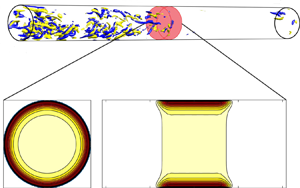Article contents
Designing a minimal baffle to destabilise turbulence in pipe flows
Published online by Cambridge University Press: 13 August 2020
Abstract

Motivated by the results of recent experiments (Kühnen et al., Flow Turbul. Combust., vol. 100, 2018, pp. 919–943), we consider the problem of designing a baffle (an obstacle to the flow) to relaminarise turbulence in pipe flows. Modelling the baffle as a spatial distribution of linear drag  ${\boldsymbol {F}}(\boldsymbol {x},t)=-\chi (\boldsymbol {x})\boldsymbol {u}_{tot}(\boldsymbol {x},t)$ within the flow (
${\boldsymbol {F}}(\boldsymbol {x},t)=-\chi (\boldsymbol {x})\boldsymbol {u}_{tot}(\boldsymbol {x},t)$ within the flow ( $\boldsymbol {u}_{tot}$ is the total velocity field and
$\boldsymbol {u}_{tot}$ is the total velocity field and  $\chi \ge 0$ a scalar field), two different optimisation problems are considered to design
$\chi \ge 0$ a scalar field), two different optimisation problems are considered to design  $\chi$ at a Reynolds number
$\chi$ at a Reynolds number  $Re=3000$. In the first, the smallest baffle defined in terms of a
$Re=3000$. In the first, the smallest baffle defined in terms of a  $L_1$ norm of
$L_1$ norm of  $\chi$ is sought which minimises the viscous dissipation rate of the flow. In the second, a baffle which minimises the total energy consumption of the flow is treated. Both problems indicate that the baffle should be axisymmetric and radially localised near the pipe wall, but struggle to predict the optimal streamwise extent. A manual search finds an optimal baffle one radius long which is then used to study how the amplitude for relaminarisation varies with
$\chi$ is sought which minimises the viscous dissipation rate of the flow. In the second, a baffle which minimises the total energy consumption of the flow is treated. Both problems indicate that the baffle should be axisymmetric and radially localised near the pipe wall, but struggle to predict the optimal streamwise extent. A manual search finds an optimal baffle one radius long which is then used to study how the amplitude for relaminarisation varies with  $Re$ up to
$Re$ up to  $15\,000$. Large stress reduction is found at the pipe wall, but at the expense of an increased pressure drop across the baffle. Estimates are then made of the break-even point downstream of the baffle where the stress reduction at the wall due to the relaminarised flow compensates for the extra drag produced by the baffle.
$15\,000$. Large stress reduction is found at the pipe wall, but at the expense of an increased pressure drop across the baffle. Estimates are then made of the break-even point downstream of the baffle where the stress reduction at the wall due to the relaminarised flow compensates for the extra drag produced by the baffle.
JFM classification
Information
- Type
- JFM Papers
- Information
- Copyright
- © The Author(s), 2020. Published by Cambridge University Press
References
REFERENCES
- 10
- Cited by

